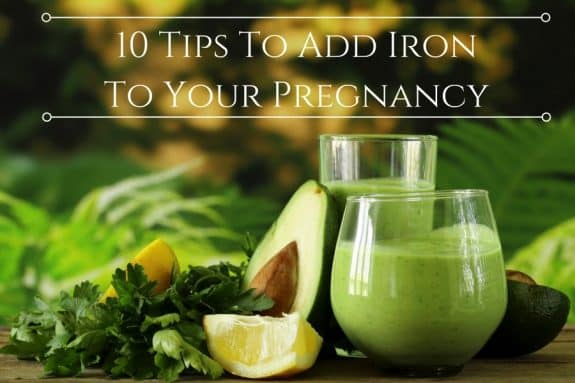Necessary for the production and health of red blood cells, iron is a vital nutrient. It is especially important for women who are pregnant because it ensures that both you and the baby are getting the oxygen you need. Unfortunately, around half of all pregnant women suffer from some form of anemia. Protect the health of you and your baby by learning how to add more iron to your diet.
Understand the difference between heme and non-heme iron.
There are two main types of iron: heme iron and non-heme iron. Heme iron, which is found in animal products, is more easily absorbed by the body. Non-heme iron is found in plant-based sources. Expectant mothers should consume both, but the way they are absorbed will change the way you consume these foods, and will impact how much you need to reach your daily iron intake goal. Heme foods should be consumed in your recommended daily amounts (2-3 servings per day), but you should also add in non-heme foods because they are typically digested better by the body. Up the absorption of the iron they contain by pairing non-heme foods with foods rich in vitamin C (broccoli, oranges, mangos, etc.)
Focus on Nutrient-Dense Foods
While there are many foods that contain iron, those that are at risk for iron deficiency should focus on consuming more nutrient dense foods. For example, oysters contain at least 3.5 milligrams or iron while sockeye salmon and tuna contain much less – just 0.5 milligrams and 1.1 milligrams, respectively. So, if you are craving a seafood dish, you might consider choosing New England clam chowder over baked salmon or tuna.
Load Up on Leafy Greens
Although your plant-based iron-rich foods are non-heme foods, they contain fewer calories. You can also consume a lot more of them without the risk of overstuffing yourself. So anytime you have a dish, consider adding some leafy greens. Toss kale, spinach, or collard greens into soups, make salads using kale or spinach instead of iceberg lettuce, and maybe even search for ways to add some dark greens to your favorite treats.
Go Nutty!
Nuts and seeds are wonderful sources of non-heme iron, and they can be added to almost anything. You can toss them in homemade muffins or toss them on a bean and vegetable burrito. You use them as a topping on your favorite salad or as an additive in your morning oatmeal. They can be added to smoothies (as suggested in the next tip), or you can carry a bag with you in your purse for an easy, on-the-go snack. As an added bonus, some nuts also contain Omega 3 (chia seeds, flax seeds, walnuts, and hemp seeds).
Try a Green Smoothie
Green smoothies are more than just a health food fad; they are absolutely delicious and the possibilities for ingredients are nearly endless! Typically made with dark, leafy greens (kale, spinach, etc.) you can add both fruits and vegetables to your smoothie. For an extra boost of iron, consider tossing in some chia seeds, which have 2.2 milligrams of iron per serving, or some of your favorite nuts or seeds.
Eat Iron-Rich Grains
All too often, people forget that there are grains rich in iron. For example, most cereals are now fortified with iron, and oatmeal naturally contains some iron (add more iron to your oatmeal with a dollop of blackstrap molasses). You can also swap out white rice for brown rice or bulgur, both of which contain iron. Or you can give quinoa – the only complete plant-based protein – a try. Tabouli is a popular way to introduce yourself to this power grain, but it is far from the only dish worth trying.
Add Non-Heme Iron to Your Favorite Dishes
Most health-conscious vegetarians and vegans know that every dish needs a bean, lentil, or other plant-based iron in it. But you do not have to be vegetarian to boost your iron intake with beans, tofu, tempeh, or other low-calorie, non-heme iron foods. You can add tofu or bean sprouts to your favorite beef or chicken stir fry. Another great idea is to blend up some light-colored beans and then add it to your favorite soup (chickpeas and cannelli beans are difficult to detect, even for the pickiest of eaters). Or simply add some beans to your favorite salad. Soybeans and chickpeas are some of the most iron-rich beans, but even pintos, which are on the lower end of the iron scale, contain 3.6 milligrams per one cup serving.
Watch for Foods that Hinder Iron Absorption
While vitamin C increases iron absorption, there are other foods and nutrients that can actually get in the way of iron absorption. For example, coffee, tea, and calcium supplements should not be paired with meals high in iron. Instead, try taking your calcium supplements right before bed and only consume tea or coffee several hours before or after your meals.
Up Your B-Vitamin Intake
While most anemias in pregnancy are iron-deficiency anemias, some can stem from a lack of folate and/or B-12. As such, women should ensure they are getting enough of both nutrients while pregnancy. Foods like eggs, cheese, and meat all contain B-12. (Note: If you are vegetarian or vegan, you should definitely be taking a B-12 supplement. While some plant sources may contain trace amounts of B-12, none contain enough to ensure you meet your daily intake requirements.) Folate can be found in fortified foods, such as cereals and pastas, and in leafy green vegetables, such as spinach. Beans and lentils are also a great source of folate, which is all the more reason to add them to your favorite meat dishes.
Discuss Supplementation with Your Doctor
Although you may be able to treat mild iron deficiency with diet, severe and persistent cases should be discussed with your obstetrician. Feelings of fatigue, irritability are key signs. Blood will most likely be drawn and, if your levels are low enough, your doctor may prescribe iron supplements. It is important to note that supplementation should only be done at the instruction of a qualified physician. Iron overdose is possible with supplementation and it can lead to serious complications for both you and baby. (Note: Iron poisoning is highly unlikely – maybe even impossible – for those consuming iron only through food intake.)








I took Floradix when I was pregnant. I just couldn’t get enough iron naturally and my doctor said it would help.